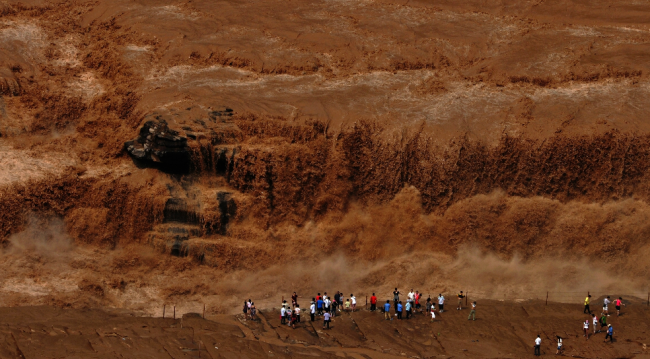Introduction to Scenic Spots of Yellow River Tourism Route
Introduction to Scenic Spots

Hukou Waterfall: Hukou Waterfall in Linfen, Shanxi is the only yellow waterfall on the Yellow River and the second largest waterfall in China, known as the "Wonder of the Yellow River". The scenic area centered around Hukou Waterfall integrates the Yellow River Canyon, Loess Plateau, and ancient plateau villages, showcasing the natural landscape and rich historical and cultural heritage of the Yellow River Basin. The rolling Yellow River water has reached this point, and a torrent over 500 meters wide has suddenly been bound by both sides. It is wide on top and narrow on the bottom, tumbling and surging in a 50 meter drop, with a sound like pouring out of a huge pot, hence the name "Hukou Waterfall". In 1988, it was designated as a national key scenic spot in China. In 1991, it was rated as one of the "Top 40 Tourist Attractions in China". In 2002, it was promoted to a national geological park and is a national AAAA level tourist attraction.
Longmen Scenic Area: Longmen is the throat of the Yellow River, with cliffs on both sides facing each other like gates. Legend has it that only the divine dragon can cross, hence the name Longmen. According to legend, it was excavated by the Great Yu during the flood control, also known as Yumen. To the north is the Yellow River Canyon, which is sandwiched by mountains, and to the south is a flat and open plain with a huge contrast. The width of the river here is less than 80 meters, so there has always been a saying that "there is no wind, three feet of waves, and a thunder on the flat ground".
Stork Tower: Stork Tower, also known as Stork Magpie Tower, is named after the presence of storks perching on it. It is located on the east bank of the Yellow River to the west of the ancient city of Puzhou in Yongji City, Shanxi Province. It is a national AAAA level tourist attraction, covering an area of 2.064 square kilometers. Stork Tower was first built during the Northern Zhou Dynasty (approximately 557-580 AD) and lasted for more than 700 years from the Sui, Tang, Five Dynasties, Song, and Jin dynasties. In the early Yuan Dynasty, Genghis Khan's Jin Ge Tie Ma attacked the Central Plains and was destroyed by soldiers, leaving only its original site. At the beginning of the Ming Dynasty, the former site still existed, but later due to the flooding of the Yellow River and frequent fluctuations of the river, its former site became difficult to find. People can only regard the Xicheng Tower in Puzhou as the "Stork Tower". Due to its magnificent structure and beautiful surrounding scenery, during the Tang and Song dynasties, literati and scholars climbed the tower to appreciate the scenery and left behind many immortal poems, with Wang Zhihuan's "Climbing the Stork Tower" being the most famous. The Stork Tower is a Tang style building with four eaves and three floors, with a height of 73.9 meters. It faces south and north, originally along the Yellow River, with Zhongtiao Mountain to the south. From a distance, one can overlook the Shundu Site, and from the sky, one can overlook the water of the Yellow River. The Stork Tower is part of the Yellow River culture.
Qikou Ancient Town: Qikou Ancient Town is located 50 kilometers south of Linxian City in Shanxi Province, adjacent to Lvliang Mountain and bordered by the Yellow River. It is a famous historical and cultural town in China. Xiwan Village in the town is one of the first batch of famous historical and cultural villages in China. Xiwan Castle, not far from Qikou, features a complex of ancient buildings from the Ming and Qing dynasties, complementing and complementing the Loess Plateau. Qikou was a military stronghold in ancient times. During the Ming, Qing, and Republic of China periods, it became a famous commercial center in northern China thanks to the Yellow River water transportation. It borders Shaanxi, Gansu, Ningxia, and Mongolia to the west, Taiyuan, Beijing, and Tianjin to the east, and is a hub of economy and culture between the east and the west. It is known as the "First Town of the Nine Bend Yellow River".